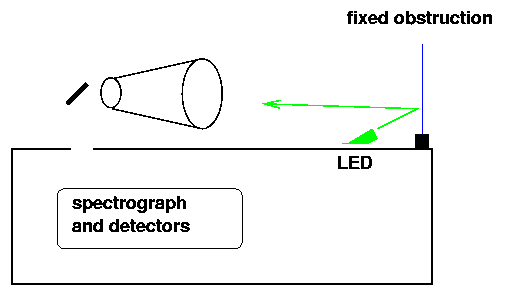

Table of Contents
Send a free-flying spacecraft into low earth orbit (LEO).
Place on board:
The main advantages of a freeflyer:
There are several instruments which currently (or in the near future) measure the solar irradiance. For example,
By using the Sun as a reference source, we let other groups do much of the hard work.
We can, of course, include several on-board sources as additional references, just to verify that the instruments are not suffering significant contamination or degradation. LEDs are a reasonable choice, and the "fixed obstruction" method mentioned below provides a natural way to send light from an LED through the main optics into the detector.
How can we measure sunlight through the very same optical path as starlight? Two options involve reflected sunlight.


Method Pro Con
---------------------------------------------------------------------
shoot "nerf balls" no effect on ordinary only a few chances
observations moving parts
objects in focus requires tracking balls
cannot check reflectance
fixed obstruction will definitely be object not in focus
recorded small effect on ordinary
observations
can check reflectance
---------------------------------------------------------------------
Each method has its advantages and disadvantages.
The analysis of the "nerf ball" method is relatively simple: each ball (eventually) becomes a point source in images and can be compared easily to stars. The analysis of the "obstruction" method is more difficult: since the object will be very far from focus, its light will appear as a diffuse background on images. Nevertheless, as the satellite passes into and out of the Earth's shadow, one can measure the change in this background accurately; it is a matter of geometry and optics to convert the background into an effective solar irradiance.
On the other hand, the logistics of making the measurements favors the fixed obstruction. The MSX experiment fired five spheres away from the satellite, but managed to track only two of those completely as they moved away from the spacecraft. The obstruction is always in the same place, and never has to move. Moreover, one can shine an internal light source onto the obstruction while in the Earth's shadow to check the reflectivity of the obstruction, both as a function of wavelength, and as a function of time on orbit.

One can calculate the signal to noise ratio for measurements of stars by comparing the signal (starlight) to the sources of noise (starlight, background, readnoise, dark current); see Howell (1989) for details.
I made the following assumptions:
The results, in tabular form. Each table shows the overall signal-to-noise ratio per wavelength bin element for a set of exposure times (in seconds) and a set of telescope diameters. There are tables for stellar magnitudes ranging from 0 to 15.
First, measurements in the optical: SNAP filter 1, centered on 515 nm, similar to Johnson V.
# star mag 0 # exptime= 0.1 1.0 10.0 100.0 1000.0 10000.0 D = 5 7.860e+00 3.474e+01 1.155e+02 3.672e+02 1.162e+03 3.674e+03 D = 10 2.041e+01 7.242e+01 2.320e+02 7.347e+02 2.324e+03 7.348e+03 D = 20 4.484e+01 1.464e+02 4.646e+02 1.470e+03 4.647e+03 1.470e+04 D = 50 1.155e+02 3.672e+02 1.162e+03 3.674e+03 1.162e+04 3.674e+04 D = 100 2.320e+02 7.347e+02 2.324e+03 7.348e+03 2.324e+04 7.348e+04 # star mag 5 # exptime= 0.1 1.0 10.0 100.0 1000.0 10000.0 D = 5 1.063e-01 1.025e+00 7.859e+00 3.473e+01 1.155e+02 3.671e+02 D = 10 4.199e-01 3.691e+00 2.041e+01 7.241e+01 2.320e+02 7.347e+02 D = 20 1.603e+00 1.114e+01 4.484e+01 1.464e+02 4.646e+02 1.470e+03 D = 50 7.860e+00 3.474e+01 1.155e+02 3.672e+02 1.162e+03 3.674e+03 D = 100 2.041e+01 7.242e+01 2.320e+02 7.347e+02 2.324e+03 7.348e+03 # star mag 10 # exptime= 0.1 1.0 10.0 100.0 1000.0 10000.0 D = 5 1.067e-03 1.067e-02 1.063e-01 1.023e+00 7.794e+00 3.418e+01 D = 10 4.268e-03 4.262e-02 4.198e-01 3.687e+00 2.034e+01 7.209e+01 D = 20 1.706e-02 1.696e-01 1.603e+00 1.113e+01 4.479e+01 1.463e+02 D = 50 1.063e-01 1.025e+00 7.859e+00 3.473e+01 1.155e+02 3.671e+02 D = 100 4.199e-01 3.691e+00 2.041e+01 7.241e+01 2.320e+02 7.347e+02 # star mag 15 # exptime= 0.1 1.0 10.0 100.0 1000.0 10000.0 D = 5 1.067e-05 1.067e-04 1.067e-03 1.065e-02 1.047e-01 9.026e-01 D = 10 4.269e-05 4.269e-04 4.267e-03 4.255e-02 4.136e-01 3.322e+00 D = 20 1.707e-04 1.707e-03 1.706e-02 1.693e-01 1.581e+00 1.046e+01 D = 50 1.067e-03 1.067e-02 1.063e-01 1.023e+00 7.794e+00 3.418e+01 D = 100 4.268e-03 4.262e-02 4.198e-01 3.687e+00 2.034e+01 7.209e+01
Now, measurements in the near-IR: SNAP filter 7, centered on 1300 nm.
# star mag 0 # exptime= 0.1 1.0 10.0 100.0 1000.0 10000.0 D = 5 8.195e-01 7.758e+00 5.433e+01 2.200e+02 7.193e+02 2.282e+03 D = 10 3.217e+00 2.675e+01 1.323e+02 4.525e+02 1.443e+03 4.567e+03 D = 20 1.200e+01 7.512e+01 2.822e+02 9.114e+02 2.888e+03 9.136e+03 D = 50 5.434e+01 2.201e+02 7.195e+02 2.283e+03 7.223e+03 2.284e+04 D = 100 1.323e+02 4.525e+02 1.443e+03 4.568e+03 1.445e+04 4.568e+04 # star mag 5 # exptime= 0.1 1.0 10.0 100.0 1000.0 10000.0 D = 5 8.248e-03 8.243e-02 8.191e-01 7.724e+00 5.320e+01 2.127e+02 D = 10 3.299e-02 3.291e-01 3.215e+00 2.666e+01 1.313e+02 4.483e+02 D = 20 1.318e-01 1.306e+00 1.200e+01 7.500e+01 2.816e+02 9.093e+02 D = 50 8.195e-01 7.758e+00 5.433e+01 2.200e+02 7.193e+02 2.282e+03 D = 100 3.217e+00 2.675e+01 1.323e+02 4.525e+02 1.443e+03 4.567e+03 # star mag 10 # exptime= 0.1 1.0 10.0 100.0 1000.0 10000.0 D = 5 8.249e-05 8.248e-04 8.244e-03 8.203e-02 7.819e-01 5.651e+00 D = 10 3.299e-04 3.299e-03 3.297e-02 3.275e-01 3.074e+00 2.078e+01 D = 20 1.320e-03 1.320e-02 1.318e-01 1.300e+00 1.154e+01 6.528e+01 D = 50 8.248e-03 8.243e-02 8.191e-01 7.724e+00 5.320e+01 2.127e+02 D = 100 3.299e-02 3.291e-01 3.215e+00 2.666e+01 1.313e+02 4.483e+02 # star mag 15 # exptime= 0.1 1.0 10.0 100.0 1000.0 10000.0 D = 5 8.249e-07 8.248e-06 8.245e-05 8.208e-04 7.864e-03 5.831e-02 D = 10 3.300e-06 3.299e-05 3.298e-04 3.283e-03 3.145e-02 2.330e-01 D = 20 1.320e-05 1.320e-04 1.319e-03 1.313e-02 1.257e-01 9.284e-01 D = 50 8.249e-05 8.248e-04 8.244e-03 8.203e-02 7.819e-01 5.651e+00 D = 100 3.299e-04 3.299e-03 3.297e-02 3.275e-01 3.074e+00 2.078e+01
Scientific criteria only: